Featured instruments from Vintage American Guitar.
-
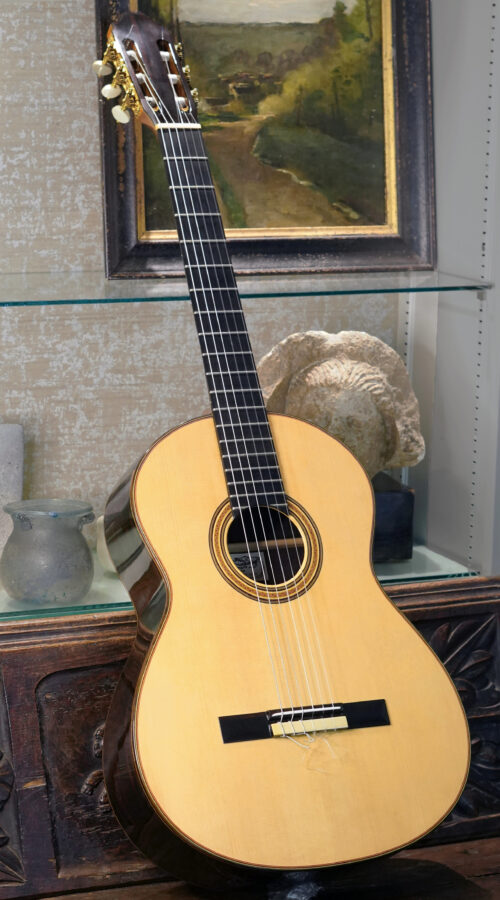 Ken Miller, a great and meticulous luthier, is now retired and is not taking any guitar orders. He started building in early 1960s and in the 1970’s worked at Guild Guitars in Rhode Island, in a variety of positions. He was a full-time luthier with his own brand of guitars from 1999 until retirement in 2015. His guitars are hard to come by – especially his classical guitars as he made only a small number of classicals over the years. “I made all of my Classical and Flamenco guitars in 650mm scale, and with the body size and shape of this one,” said Ken in a recent conversation with us. “The Flamenco guitars had slightly different internals, lower bridge and were made with Spanish Cypress back & sides, and friction pegs. All I made, classical or flamenco, were 650mm scale. I think that those Spanish instruments from about 1900 through the '30's were the cream of the crop. I don't care for the modern, larger classical guitars… My two guitar heroes were Santos Hernandez, and CF Martin.” See/listen to a recording of this guitar being played, in the video posted here. This classical guitar is 20 years old, but you can’t tell by looking at it, it’s near pristine in terms of play wear. It has a big, rich, lush sound. It really excels in the ringing Brazilian rosewood trebles. And it’s one of the few guitars you’ll find where you can get incredible nuance with just a light touch. • Serial number: #70, made in 2003. (Signed as such on label) • Old growth, dark Brazilian Rosewood back/sides, head plate overlay, binding and bridge. (Note, a few “eyes” in the Brazilian on back, were wormholes in the very dark, very old Brazilian that the luthier very well plugged before putting the guitar together.) • The top, and internal bracings are Adirondack (Red) Spruce • There are 7 slender fan braces with a thin horizontal brace under the bridge area between braces 1 and 7 • Ebony fingerboard • Spanish Cedar internal lining as is the neck which has a graphite reinforcement. Fitted to the body with a traditional Spanish foot. • Nut, saddle & bridge tie plate are Fossil Ivory. • Nut is 51.5mm • 650mm scale • Handmade rosette • Oil varnish finish • Gotoh Deluxe tuners with Ivoroid tuner buttons There is one, very small crack that’s difficult to see/photograph on the back of the guitar near the center seam that is near the area of the end pin. The top of the guitar, with no cracks whatsoever, looks virtually unplayed, as does the fretboard and frets. This guitar sold for $6,000 new, in 2003, and it’s about as close to that original ’03 condition as you can get. With its very dark, old growth Brazilian rosewood, it’s easily comparable in build quality, materials, and sound, to classicals in the $8-14K range today. Price: $4,850. With modern case.
Ken Miller, a great and meticulous luthier, is now retired and is not taking any guitar orders. He started building in early 1960s and in the 1970’s worked at Guild Guitars in Rhode Island, in a variety of positions. He was a full-time luthier with his own brand of guitars from 1999 until retirement in 2015. His guitars are hard to come by – especially his classical guitars as he made only a small number of classicals over the years. “I made all of my Classical and Flamenco guitars in 650mm scale, and with the body size and shape of this one,” said Ken in a recent conversation with us. “The Flamenco guitars had slightly different internals, lower bridge and were made with Spanish Cypress back & sides, and friction pegs. All I made, classical or flamenco, were 650mm scale. I think that those Spanish instruments from about 1900 through the '30's were the cream of the crop. I don't care for the modern, larger classical guitars… My two guitar heroes were Santos Hernandez, and CF Martin.” See/listen to a recording of this guitar being played, in the video posted here. This classical guitar is 20 years old, but you can’t tell by looking at it, it’s near pristine in terms of play wear. It has a big, rich, lush sound. It really excels in the ringing Brazilian rosewood trebles. And it’s one of the few guitars you’ll find where you can get incredible nuance with just a light touch. • Serial number: #70, made in 2003. (Signed as such on label) • Old growth, dark Brazilian Rosewood back/sides, head plate overlay, binding and bridge. (Note, a few “eyes” in the Brazilian on back, were wormholes in the very dark, very old Brazilian that the luthier very well plugged before putting the guitar together.) • The top, and internal bracings are Adirondack (Red) Spruce • There are 7 slender fan braces with a thin horizontal brace under the bridge area between braces 1 and 7 • Ebony fingerboard • Spanish Cedar internal lining as is the neck which has a graphite reinforcement. Fitted to the body with a traditional Spanish foot. • Nut, saddle & bridge tie plate are Fossil Ivory. • Nut is 51.5mm • 650mm scale • Handmade rosette • Oil varnish finish • Gotoh Deluxe tuners with Ivoroid tuner buttons There is one, very small crack that’s difficult to see/photograph on the back of the guitar near the center seam that is near the area of the end pin. The top of the guitar, with no cracks whatsoever, looks virtually unplayed, as does the fretboard and frets. This guitar sold for $6,000 new, in 2003, and it’s about as close to that original ’03 condition as you can get. With its very dark, old growth Brazilian rosewood, it’s easily comparable in build quality, materials, and sound, to classicals in the $8-14K range today. Price: $4,850. With modern case. -
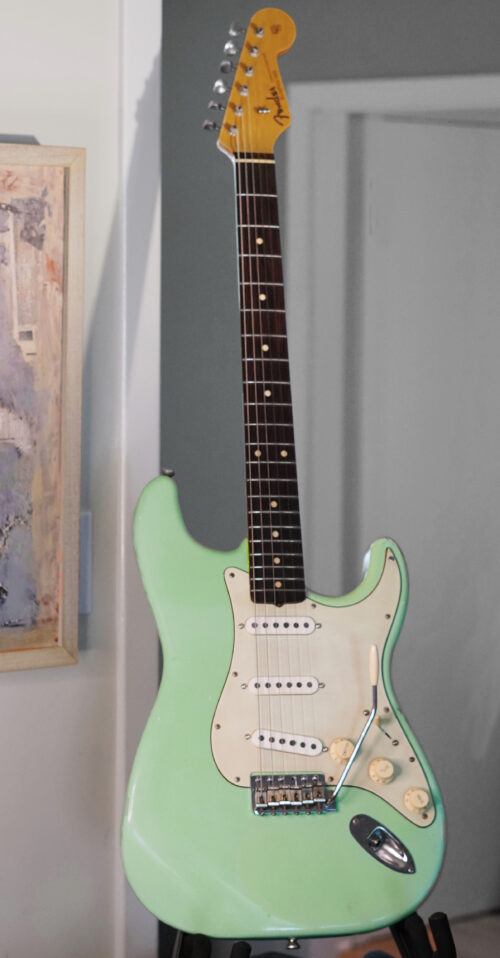 63 Surf Green Strat tribute. Impeccable attention to detail. And more importantly, the right sound, and feel. It never left the Fullerton factory as you see it here – it’s a great tribute build that not only looks right, it plays like a dream. Loud and resonant, even when not plugged in. You can spend $6K plus, on a recent Fender Custom Shop versions, but it won't look this good and it won't play like this. Thin nitro cellulose finish, with light relic. Klein pickups, the choice of players who need the best authentic sound. Includes many Fender licensed parts, that makes it legit on the market. Strat is '63 spec, and note it has a chunky neck. Surf Green is as it should be, with the just a tiny touch of yellowy tint in places on guitar top, as what happens to a true vintage Surf Green finish after years of fading. Price: $3650. Ships in a well-used modern strat case.
63 Surf Green Strat tribute. Impeccable attention to detail. And more importantly, the right sound, and feel. It never left the Fullerton factory as you see it here – it’s a great tribute build that not only looks right, it plays like a dream. Loud and resonant, even when not plugged in. You can spend $6K plus, on a recent Fender Custom Shop versions, but it won't look this good and it won't play like this. Thin nitro cellulose finish, with light relic. Klein pickups, the choice of players who need the best authentic sound. Includes many Fender licensed parts, that makes it legit on the market. Strat is '63 spec, and note it has a chunky neck. Surf Green is as it should be, with the just a tiny touch of yellowy tint in places on guitar top, as what happens to a true vintage Surf Green finish after years of fading. Price: $3650. Ships in a well-used modern strat case. -
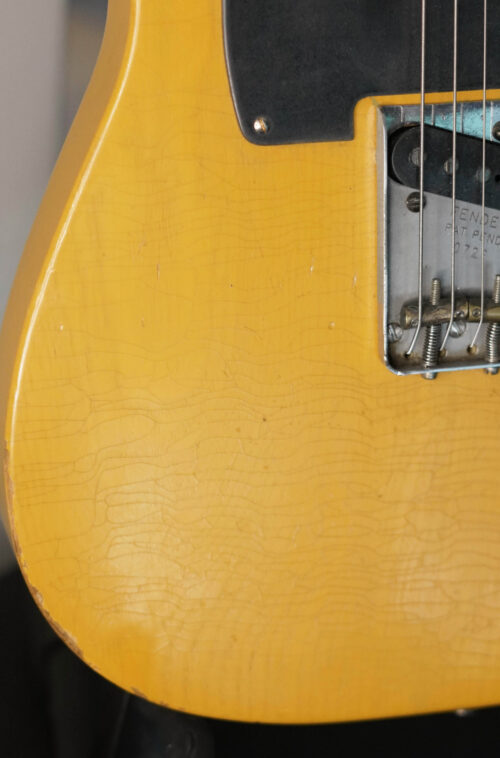 52 Broadcaster. Impeccable attention to detail. Great sound, and feel. No, it never left the Fullerton factory as you see it here. This is one of the best tribute builds you'll find, at any price, done by real players. You can spend $6K plus, on a recent Fender Custom Shop version, but it won't look this good and it won't play like this. The best nitro cellulose finish, with light relic, and crazing. MJT body. Warmoth Fender licensed birds eye maple neck, chunky C-shape. Duncan Antiquity pickups. The bridge– with the numbers you see– is not available on a "Custom Shop" or reissue. It was custom made and on the instrument when we acquired it. Price: $3750. Ships in a well-worn modern tele case.
52 Broadcaster. Impeccable attention to detail. Great sound, and feel. No, it never left the Fullerton factory as you see it here. This is one of the best tribute builds you'll find, at any price, done by real players. You can spend $6K plus, on a recent Fender Custom Shop version, but it won't look this good and it won't play like this. The best nitro cellulose finish, with light relic, and crazing. MJT body. Warmoth Fender licensed birds eye maple neck, chunky C-shape. Duncan Antiquity pickups. The bridge– with the numbers you see– is not available on a "Custom Shop" or reissue. It was custom made and on the instrument when we acquired it. Price: $3750. Ships in a well-worn modern tele case. -
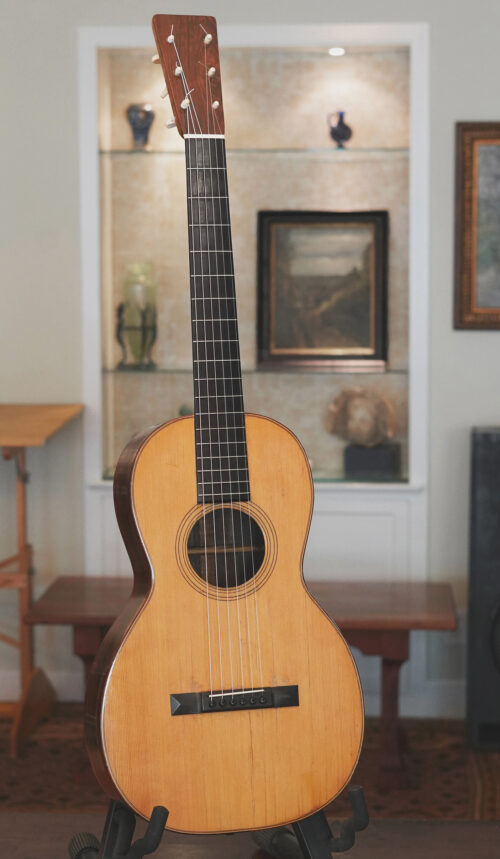
In this period (any Martin guitar made before 1898) there were of course no serial numbers on Martins, and no one signed the instruments inside with a date as they often did in the later 1880’s. But it has all the hallmarks of 1870s to mid-1880’s – and most likely earlier in that period, about 1870, judging by the endstrip material.
It has the original friction tuners – with the exception of the Low E string tuner that was missing and so has been replaced (probably a hundred years ago) with a tuning peg to match the originals.
The size 2 is a great size, it’s a larger guitar than the more common size 2 ½ from this era.
Amazing tone from this guitar. See and hear this guitar being played:
All careful work has been done on this guitar, and it won’t need anything else – it’s a great guitar for the player who wants the best Martin tone and playability – a tonal gem from the 19th century Martin factory in Nazareth.
• Spruce top over Brazilian Rosewood back and sides.
• Spanish heel (not the ice cream cone heel of the less expensive Martins)
• Peg head, with original tuners (with one replacement– the high E string peg)
• Light overspray on top done ages ago, so it’s not very noticeable.
A bit more overspray on back and sides, done decades and decades ago.
• Fan braced – as are most of the best sounding Martins from this era.
• Original thin maple bridge plate
• Original ebony fretboard; Original bar frets with some wear but they’re still pretty high.
• Soft V neck
• Scale length: 24.5 inches
• Width at lower bout: 12 inches
• Nut width: 1 13/16 inch
Multiple cracks on top, all repaired (see photos); multiple cracks on back, all repaired.
Heel has a tiny crack – but it looks like there was never any separation, more of surface crack (see photos)
Two areas by top edge of bridge, either end, where wood was splintered a bit, now repaired and stable. (See photos)
This guitar has seen multiple crack repairs, but it’s structurally sound now, and needs no work going forward. It’s priced low to reflect the work done. It has marvelous sound and projection, and plays with great low action and great intonation all up and down the fretboard. Strung with Savarez Alliance strings.
It would be a great addition to a player wanting a superb example of the best Martin sound from the 19th century – at an affordable cost that’s impossible to find in today’s market.
Ships in a modern hard shell case.
Price: $4,850. – plus shipping
-
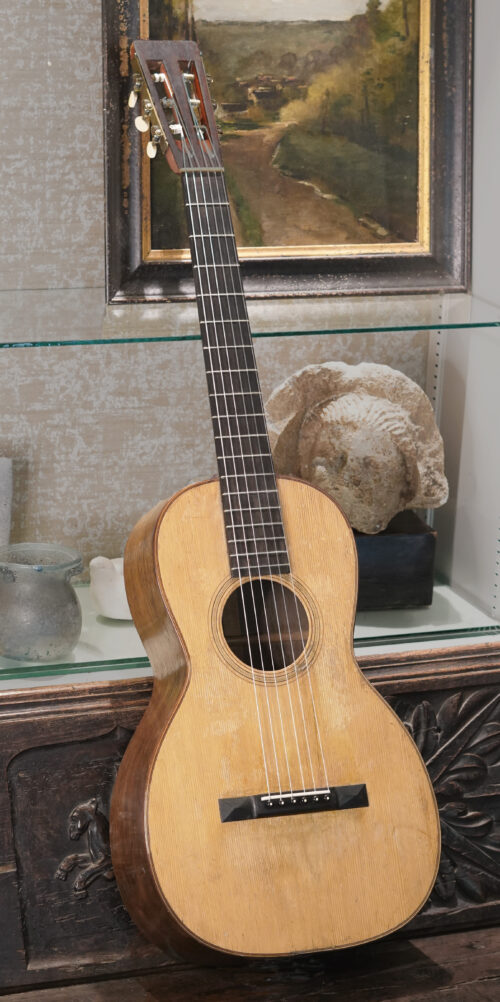
In this period, the Martin factory foreman often wrote the date of manufacture, before the guitar left the factory, hand-written in pencil on the underside of the top. This one has hand-written inside "5 / 1886". It’s a nice touch to a great Martin – and the size 2 is a great size, it’s a larger guitar than the more common size 2 ½ from this era.
Exquisite tone from this guitar. See and hear this guitar being played:
All careful work has been done on this guitar, including a perfect ebony bridge by T.J. Thompson, and it won’t need anything else. It’s an ideal guitar for the player who wants the best Martin tone and playability – a tonal gem from the 19th century Martin factory in Nazareth.
• Slot head, with original geared tuners
• Spruce top over Brazilian Rosewood back and sides.
• All original finish, with the exception of some minor touch up in the bridge area.
• Perfect reproduction ebony, pyramid bridge by T.J. Thompson.
Some touch-up in the bridge area of the spruce when the bridge was fitted.
• Fan braced – as are most of the best sounding Martins from this era.
• Original thin maple bridge plate, that has had some minor pin hole attention, by us, to ensure stability and protection from ball ends.
• Original ebony fretboard; Original bar frets. Frets have some wear, but we left them, for originality, and they play fast and low and smooth.
• Spanish heel (not the ice cream cone heel of the less expensive Martins of the era).
• Soft V neck
• End pin is original, tab end of the pin has come off but the shaft remains
• One inch area in the rosette, repaired (see photos)
• Three tiny holes near end pin are remnant of a tailpiece used at some point in the previous century
• One crack on top, just below the low E string (see photos). About 4 1/2 inches long. This crack has been glued, and is tight (no cleat due to proximity to a brace).
• Scale length: 24.5 inches
• Width at lower bout: 12 inches
• Nut width: 1 13/16 inch
The guitar has had a recent neck set (by us), so the action is great, and lower than what a lot of folks try to get away with on a 19th century Martin. This guitar does not have “classical guitar action.” The great Martins from this era were not then and they should not today be considered “classical guitars”. They are parlor guitars, and the best examples have the Martin sound we know and love, with a “classical” sound if we consider that sound from the 19th century not today.
No excuses on the action, tone, and playability on this guitar. Strung with Savarez Alliance strings. It plays so easily, with perfect intonation all the way up the fretboard, and the sound is stellar.
It ships in a modern hard shell case.
Price: $6,750. – plus shipping
-
Out of stock
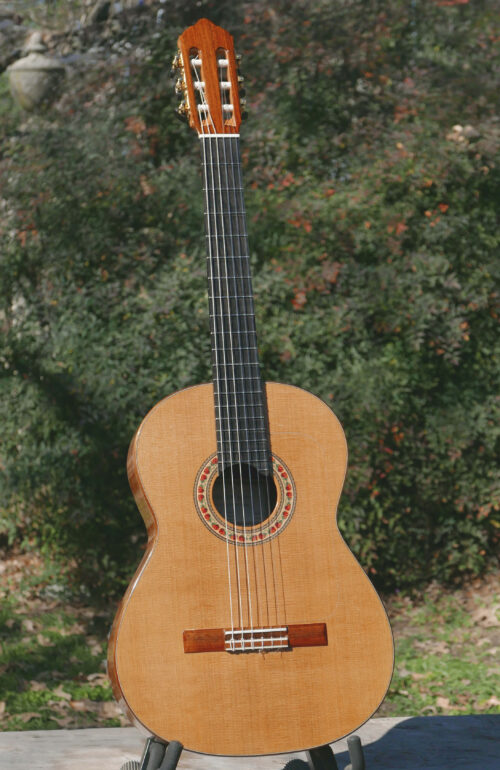 Guitars from the world-renown luthier Lester Devoe are highly sought after – to the extent of a formidable wait list for a new one. And vintage Devoe guitars – especially ones from this era – are hard to come by. So this guitar is a gem. And with close to 30 years of aged wood/tone, its sound is amazing. We’ve had several Devoe's over the years, but none like this one. The age, the fact that it’s a cedar top, its light build, and Lester’s magical touch combine to give this vintage Devoe a tone that is in a class by itself, with both the bold flamenco presence you’d expect, and nuances of color and timbre that many great/expensive classical guitars lack. Like a great classical guitar it responds to the lightest touch, and with deep round rosewood color, yet it’s a lightning storm for flamenco. You can hear/see this guitar in the sound/video clip posted here. https://www.youtube.com/watch?v=4m-M9yI6u9g 1995 Lester Devoe "Flamenco Negra", the term for a Flamenco guitar that has rosewood back and sides. See photo of label.
Guitars from the world-renown luthier Lester Devoe are highly sought after – to the extent of a formidable wait list for a new one. And vintage Devoe guitars – especially ones from this era – are hard to come by. So this guitar is a gem. And with close to 30 years of aged wood/tone, its sound is amazing. We’ve had several Devoe's over the years, but none like this one. The age, the fact that it’s a cedar top, its light build, and Lester’s magical touch combine to give this vintage Devoe a tone that is in a class by itself, with both the bold flamenco presence you’d expect, and nuances of color and timbre that many great/expensive classical guitars lack. Like a great classical guitar it responds to the lightest touch, and with deep round rosewood color, yet it’s a lightning storm for flamenco. You can hear/see this guitar in the sound/video clip posted here. https://www.youtube.com/watch?v=4m-M9yI6u9g 1995 Lester Devoe "Flamenco Negra", the term for a Flamenco guitar that has rosewood back and sides. See photo of label.- Cedar top, and Indian Rosewood back and sides
- Rosewood bridge
- Ebony fretboard
- 650mm scale length
- Sloan tuners
- Clear tap plate treble side
- All original nitrocellulose finish
- Rosette with “roses” design in the classic Andalusia tradition
- Great condition:
-
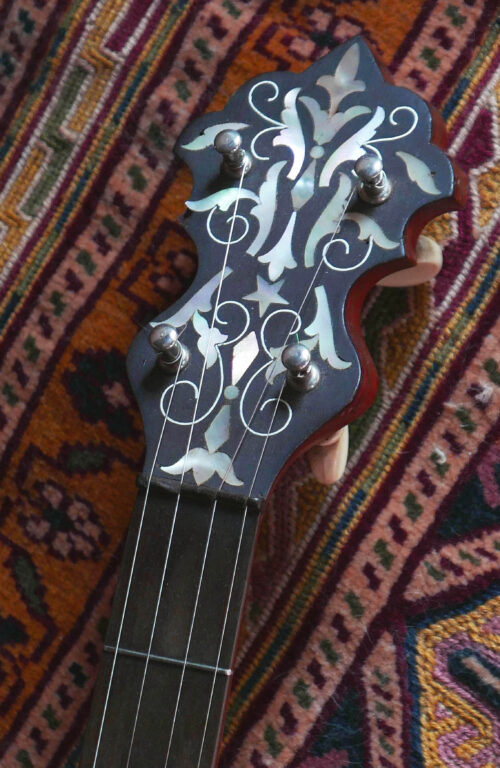 A rare, circa 1895 S.S. Stewart “Special Thoroughbred” 5-string banjo, in original condition. Silver plated pot 5-string neck is cherry Ebony fingerboard Carved heel Mother of pearl headstock inlays, with silver wire inserts also Tone ring is nickel plated on a birds-eye maple pot All of the special logos etc, are still on the inside of the banjo. Condition: amazing, original condition. Does have some wear, but it’s still shiny, and in great condition. (It even has its original leather case, not a very practical case, but original.) Tone is very nice, more focused and loud than the typical turn of the century open-back banjo. Price: $2950.
A rare, circa 1895 S.S. Stewart “Special Thoroughbred” 5-string banjo, in original condition. Silver plated pot 5-string neck is cherry Ebony fingerboard Carved heel Mother of pearl headstock inlays, with silver wire inserts also Tone ring is nickel plated on a birds-eye maple pot All of the special logos etc, are still on the inside of the banjo. Condition: amazing, original condition. Does have some wear, but it’s still shiny, and in great condition. (It even has its original leather case, not a very practical case, but original.) Tone is very nice, more focused and loud than the typical turn of the century open-back banjo. Price: $2950. -
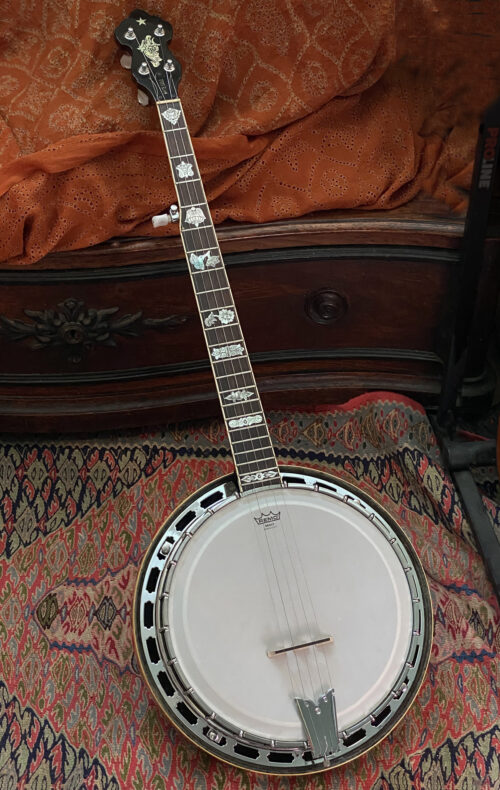
Rare Alvarez Whyte Eagle 5 string Banjo very early production
Early 1970s, but in remarkably original condition. And this instrument is from the first, early production– so it has the maple 3-ply rim. This should not be compared to later production Whyte Eagles in the 70's – this is a very rare early one with unique features, described below, and great tone.
This banjo design is based on:
• neck/head/inlays: based on the high end Fairbanks Whyte Ladye of the early 20th century– one of the most beautiful designs in banjo history
• the pot assembly is modeled closely on the Gibson TB3, archtop of the 1930's. In fact it's a remarkable recreation of that design (and sound) – a more faithful recreation that many Gibson post-war versions.Bluegrass banjo players seek out the 70’s Alvarez Whyte Eagles, known for their tone and craftsmanship. It was a pretty short window of only about five years, when these banjos were made with this kind of craftsmanship. They blow away most any banjo made and marketed (from any country) in the 60s, 70s and 80s– and they show no logos on headstock– just beautiful mother of pearl. It’s the model 4310 “Whyte Eagle”. Based on late 1920’s Vega Griffin (Tubaphone #9) style inlays, with engraved, carved heel. Sunburst finish maple banjo, Gibson-style 2 piece flange, full height 20 hole archtop tone ring, dual coordinator rods, flamed maple resonator, maple neck, chrome finish. Neck is butterfly with ebony strip on back of neck, down the center.
It’s extremely rare to find a Whyte Eagle from this very early period (serial number is 1776), when they first came out and the company bent over backwards to produce an instrument with zero compromise, from the inlays to the maple rim. The early features that are not on the later 70's Whyte Eagles, are – in addition to the 3-ply maple rim (not the 10-ply rim of almost all other Whyte Eagles) – the smaller star on the front of headstock (later models had a larger star), no “Alvarez” logo just the eagle inlay, and a darker sunburst on the resonator and also on the back of the neck.
Flamed maple resonator (sunburst back, with some of milkiness to the original finish)
Maple butterfly neck
Hand-carved heel
Mother of pearl inlays
Original tuners
Grover bridge
1 3/16 nut
Scale: 26 ¼ inches
20 hole archtop tone ring
11 inch head
With original hard shell case. Price $1850.
-
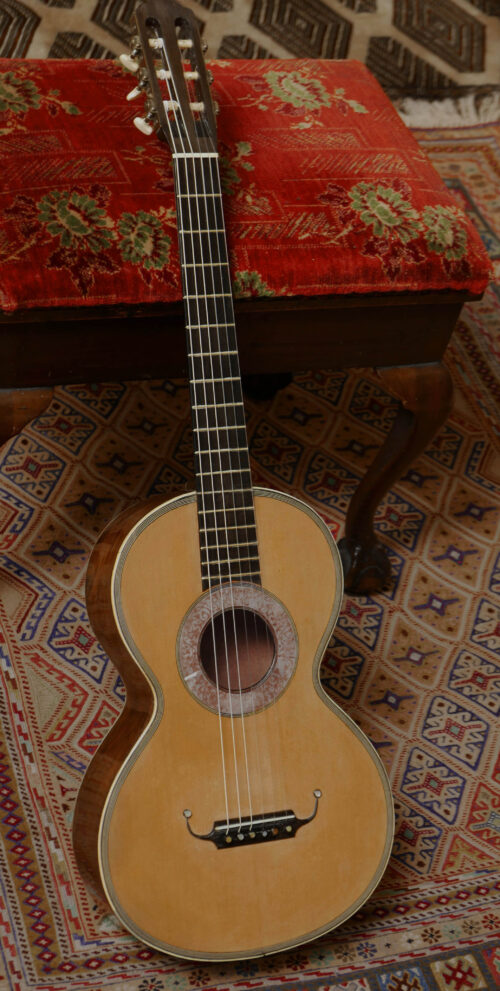 Pierre Marcard, well-known luthier in France, 1794-1867. This guitar is from about 1845–1850. Signed with the maker’s stamp/signature on inside, back (see photo). • All original: finish, bridge, frets, endpin, everything • Spruce top • Ebony bridge • Finely decorated mother of pearl rosette • Brazilian rosewood/maple laminate back • Solid Brazilian rosewood sides (note this is rare: solid, it was an upgrade from the standard practice of the day to do laminate sides as well. • Scale length: 632mm • Nut width: 46mm You can see a sound/video clip of this guitar being played, here: https://www.youtube.com/watch?v=Ryf25bMcmt4 Condition: Amazing original condition. • Similar to other fine guitars of that era, from Lacote and others, the "finish" on the top of the guitar – still all original finish and unmolested – is super thin. Those master French luthiers thought that less finish on top, was better. • No cracks on top, back, sides • A few tiny and superficial surface “cracks” on a few sections of binding • Bridge, all original, has never been off the instrument. Saddle looks original. The bridge does have a few cracks in the ebony, parallel to the length of the bridge. We have left them as is, for originality (a luthier might fill in the tiny gaps with ebony paste – the structure/integrity of the bridge is good.) • The bridge pins look original to the guitar, but hard to verify that. • Action of the guitar is good, consistent with mid nineteenth century standards. • Tone of the guitar, is excellent. Good projection for this sized instrument. Playability is very good– with good intonation even at high registers. Price: $8250. Will ship in a modern hard shell case.
Pierre Marcard, well-known luthier in France, 1794-1867. This guitar is from about 1845–1850. Signed with the maker’s stamp/signature on inside, back (see photo). • All original: finish, bridge, frets, endpin, everything • Spruce top • Ebony bridge • Finely decorated mother of pearl rosette • Brazilian rosewood/maple laminate back • Solid Brazilian rosewood sides (note this is rare: solid, it was an upgrade from the standard practice of the day to do laminate sides as well. • Scale length: 632mm • Nut width: 46mm You can see a sound/video clip of this guitar being played, here: https://www.youtube.com/watch?v=Ryf25bMcmt4 Condition: Amazing original condition. • Similar to other fine guitars of that era, from Lacote and others, the "finish" on the top of the guitar – still all original finish and unmolested – is super thin. Those master French luthiers thought that less finish on top, was better. • No cracks on top, back, sides • A few tiny and superficial surface “cracks” on a few sections of binding • Bridge, all original, has never been off the instrument. Saddle looks original. The bridge does have a few cracks in the ebony, parallel to the length of the bridge. We have left them as is, for originality (a luthier might fill in the tiny gaps with ebony paste – the structure/integrity of the bridge is good.) • The bridge pins look original to the guitar, but hard to verify that. • Action of the guitar is good, consistent with mid nineteenth century standards. • Tone of the guitar, is excellent. Good projection for this sized instrument. Playability is very good– with good intonation even at high registers. Price: $8250. Will ship in a modern hard shell case. -
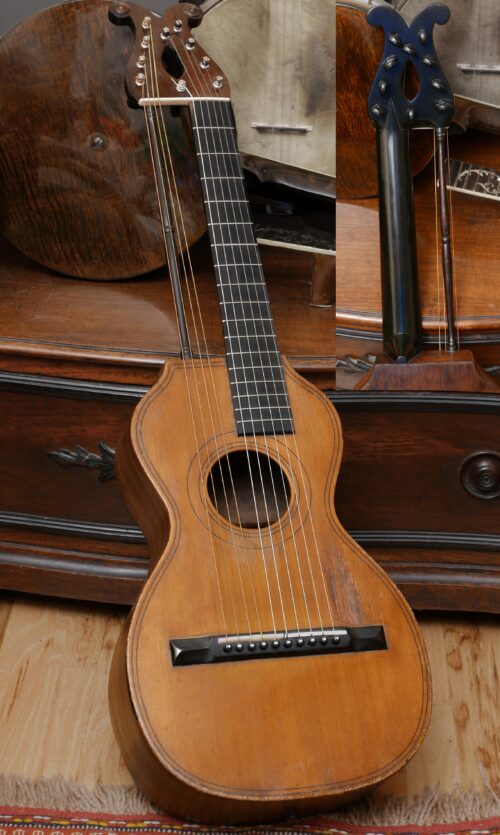 This 10 string harp guitar has no markings no it, i.e. no maker's label, stamp, signature etc. Probably American, likely a one-of-a-kind made by someone we'll never know – but it’s very similar to the 1860 "Renaissance" Martin harp guitar that’s well documented. See/hear the video of this guitar being played: https://www.youtube.com/watch?v=ddxma5gCI7Q 10 string Harp guitar: • Width at lower bout: 12 1/4 inches • It’s deep: 4 ¼ inches at bottom/end pin, 3 /12 deep at neck joint. • Scale length: 24 1/2 inches • Nut width of six-string portion: 1 7/8 inches; string spacing of six strings on the regular guitar portion: 1 ½ inches • Ladder braced – no cracks, bellying, etc, on the original top • Solid Adirondack top, with original finish • Back, and sides: Brazilian rosewood and spruce laminate (similar to some Ashborns, and some Martins from that era). There has been some restoration to the sides, where a few pieces of Brazilian were missing/chipped, as well as to the back (in other words: sections of the outer brazilian layer have been replaced. • Ebony bridge, original. It has been off, and back on • The tuners are modern banjo tuners • Ice cream cone heel, and the neck's been "ebonized". While the neck, fretboard, and head have been restored (recently), the original design is intact. • Neck is Maple – "ebonized" but it's a solid maple neck Price: $6950.
This 10 string harp guitar has no markings no it, i.e. no maker's label, stamp, signature etc. Probably American, likely a one-of-a-kind made by someone we'll never know – but it’s very similar to the 1860 "Renaissance" Martin harp guitar that’s well documented. See/hear the video of this guitar being played: https://www.youtube.com/watch?v=ddxma5gCI7Q 10 string Harp guitar: • Width at lower bout: 12 1/4 inches • It’s deep: 4 ¼ inches at bottom/end pin, 3 /12 deep at neck joint. • Scale length: 24 1/2 inches • Nut width of six-string portion: 1 7/8 inches; string spacing of six strings on the regular guitar portion: 1 ½ inches • Ladder braced – no cracks, bellying, etc, on the original top • Solid Adirondack top, with original finish • Back, and sides: Brazilian rosewood and spruce laminate (similar to some Ashborns, and some Martins from that era). There has been some restoration to the sides, where a few pieces of Brazilian were missing/chipped, as well as to the back (in other words: sections of the outer brazilian layer have been replaced. • Ebony bridge, original. It has been off, and back on • The tuners are modern banjo tuners • Ice cream cone heel, and the neck's been "ebonized". While the neck, fretboard, and head have been restored (recently), the original design is intact. • Neck is Maple – "ebonized" but it's a solid maple neck Price: $6950. -
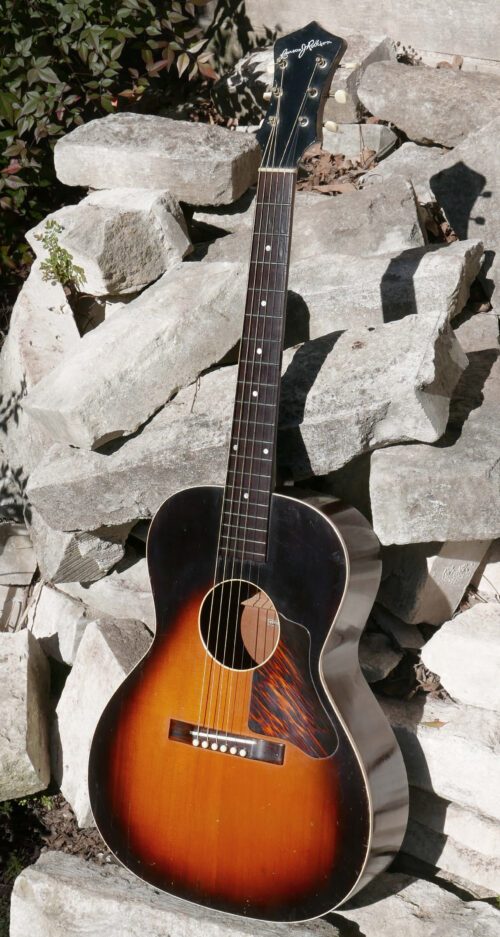 Made in 1937 – it is stamped inside from the Gibson/Kalamazoo factory: “September 1937” • Gibson L-00 (and same as Kalamazoo) body shape with ladder-bracing... all were made in the same Gibson factory. • 24 3/4" Gibson scale length • 1 3/4" nut width • Classic V-shape neck profile, typical of the golden age Gibsons of the mid-1930’s • Adirondack spruce top • Mahogany back and sides • 100% original finish, everywhere • Three hairline cracks on top that are hard to see. (upper bout; bass side near fretboard extension; and below bridge.) They’ve been glued inside. Couple of cracks on back, also have been addressed. Sides are crack-free. • Original Gibson firestripe pick guard • Original tuners (the G string tuner is bent a bit – we prefer to leave it like it is, it works fine, rather than bend it back) • Original Brazilian rosewood bridge, has never been off the guitar. • Brazilian rosewood fingerboard, shows a bit of wear • Original frets, in good condition • Original nut • Original small Maple bridge plate; and all braces inside are original and in great condition. • In a modern hard shell case Price: $3950.
Made in 1937 – it is stamped inside from the Gibson/Kalamazoo factory: “September 1937” • Gibson L-00 (and same as Kalamazoo) body shape with ladder-bracing... all were made in the same Gibson factory. • 24 3/4" Gibson scale length • 1 3/4" nut width • Classic V-shape neck profile, typical of the golden age Gibsons of the mid-1930’s • Adirondack spruce top • Mahogany back and sides • 100% original finish, everywhere • Three hairline cracks on top that are hard to see. (upper bout; bass side near fretboard extension; and below bridge.) They’ve been glued inside. Couple of cracks on back, also have been addressed. Sides are crack-free. • Original Gibson firestripe pick guard • Original tuners (the G string tuner is bent a bit – we prefer to leave it like it is, it works fine, rather than bend it back) • Original Brazilian rosewood bridge, has never been off the guitar. • Brazilian rosewood fingerboard, shows a bit of wear • Original frets, in good condition • Original nut • Original small Maple bridge plate; and all braces inside are original and in great condition. • In a modern hard shell case Price: $3950. -
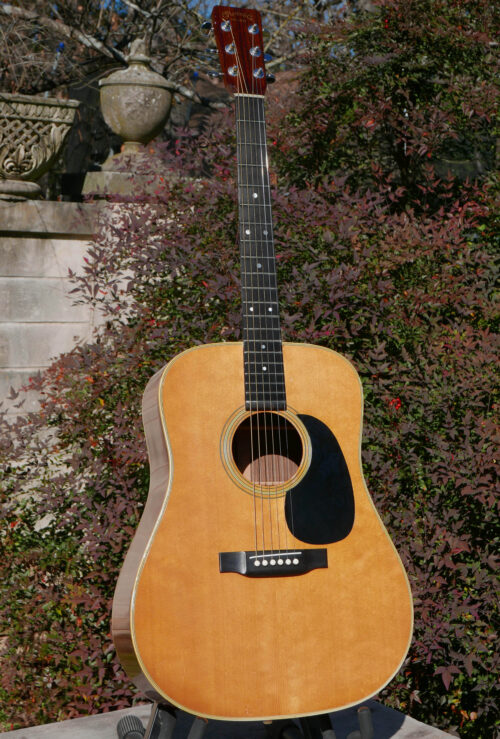 Martin D-28, made very early in 1970. Great tone, great original condition. • The finest, excellent quality Indian Rosewood back, sides, peghead veneer • Sitka Spruce top – and this is not the “streaky” sitka spruce. There are no dark streaks. Note light areas: that is “Bear claw”. • Ebony fingerboard and bridge. • Completely original. This guitar has had no repairs at all. • Original bridge, saddle, nut, pickguard • The guitar has no cracks, anywhere • Addition of a strap button on the neck heel. • Slight marks just above the nut, on bass side, caused from a strap that was worn under the strings on the peghead • The original Black Hard case (one of the last before Martin went to the Blue Plastic cases) is also very clean with no serious scrapes or bruises. One of the finest examples of 60s/early 1970 D28 available. Price: $5250.
Martin D-28, made very early in 1970. Great tone, great original condition. • The finest, excellent quality Indian Rosewood back, sides, peghead veneer • Sitka Spruce top – and this is not the “streaky” sitka spruce. There are no dark streaks. Note light areas: that is “Bear claw”. • Ebony fingerboard and bridge. • Completely original. This guitar has had no repairs at all. • Original bridge, saddle, nut, pickguard • The guitar has no cracks, anywhere • Addition of a strap button on the neck heel. • Slight marks just above the nut, on bass side, caused from a strap that was worn under the strings on the peghead • The original Black Hard case (one of the last before Martin went to the Blue Plastic cases) is also very clean with no serious scrapes or bruises. One of the finest examples of 60s/early 1970 D28 available. Price: $5250. -
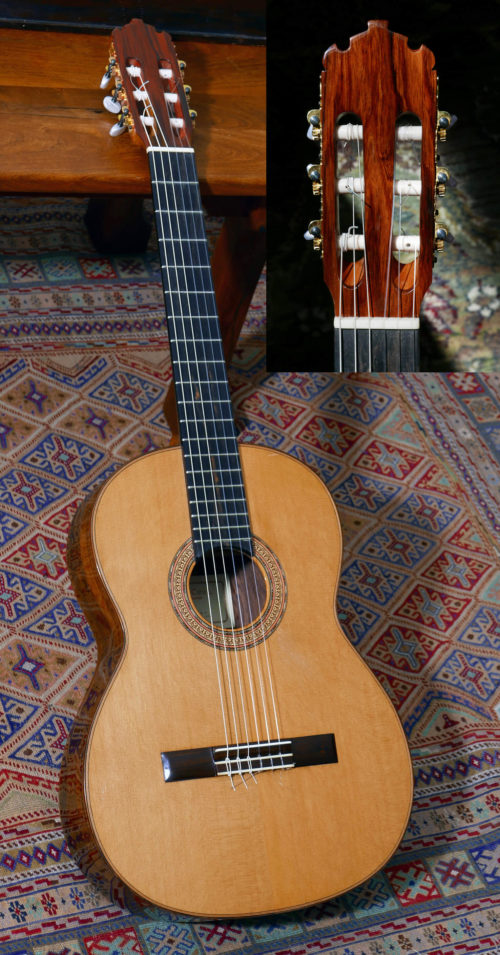 Acquired from the original owner – who bought this wonderful instrument directly from David Caro in the mountain town of the maker, one of the best luthiers that Paracho, Mexico has ever produced – in the mid 90’s and hand-carried it to California where it was lightly played. And it remains in remarkable original condition. The maker is David Caro, also known as David Caro Leonardo, or David Caro L. (In Mexico, the last/last name, in this case “Leonardo”, is the mother’s maiden name that is formally added after a person’s last [paternal] name but typically dropped in all but formal situations, documents etc.) Caro’s best instruments are among the best of a small, elite group that honed their craft at the top levels, and also benefited from visits and master classes given in Paracho by some world class luthiers from Spain, Germany, and the USA such as Felix Manzanero, Antonio Raya Pardo, Jose Romanillos, Thomas Humphery, and Herman Hauser III. Only a few Paracho luthiers have stood out over the years – Jose Navarro, Arturo Huipe, Abel Garcia, Enos Hernandez (his best work), German Vasquez Rubio, and Caro among them. See the enclosed photos from Fretboard Journal magazine, Spring 2008, that featured David Caro prominently in the feature article in that issue on Paracho luthiers. Paracho is an originally Tarascan village that sits in a high valley at 7,300 feet altitude, in the state of Michoacán, a relatively little visited state but renowned for its diversity and great beauty – and for some of the best classical guitar luthiers in the Americas. It extends from the Pacific coast, and is crossed by the Sierra Madre Del Sur in its southern part and by high volcanic mountains in its northern axis. When this guitar was made, in 1996, David Caro was at the height of his craft. And soon after, he was the first luthier to be added to the GSA calendar. This instrument is among the very best guitars ever made by Caro. And we love the model designation, it’s signed by hand on the label, “Mdo. 500”, i.e. “model 500” – sounds like a sports car name. Model 500 was the top model from Caro, in 1995/96 – using top woods, and also the best bindings, and all details. In those years, Caro’s best concert instruments went from model 100 at the base level, then ascending in tone woods and overall construction details to 200, 300, 400, then reaching the top level of “500”. So we’re calling this instrument, “el Quinientos”. (Spanish for “the 500” – nice ring to that – it’s pronounced “key-knee-éntose”) Several things make this guitar stand out as a gem: • It’s the top model from this luthier in the 1990’s • The great original condition • Scale length of 648mm. This scale length is reminiscent of Herman Hauser I’s guitars, and is firmly in the school of the shorter 650 range, not the longer scale lengths that crept in, in the last quarter of the 20th century. This is a great scale length – and note the nut width is a typical nut width of a full size classical guitar. And the neck thickness is great – on the thinner side. This combination makes it a joy to play and so easy to play – but the tone is superb. The full tone, and volume are better than most longer scale guitars. • Light weight/construction, that really allows it to sing. Its total weight, with strings, is a remarkably lithe 1430 grams • And it has great combination of woods: • Palo Escrito back and sides, bridge, and headplate veneer. DALBERGIA PALOESCRITO, is a true rosewood, a great wood that over the years came to be favored by the top luthiers in Paracho – for their top models. It sounds like Brazilian rosewood, but a tad different, and it’s not as “dark” in tone as Indian rosewood. Palo Escrito is lighter in weight and density than either brazilian or Indian rosewood. And weight, is of course part of the equation of a guitar that does translate to tone. Palo Escrito makes this guitar really breathe, and resonate. The lighter weight of this guitar is its charm, that translates to tone – slightly more airy and open, less “closed”, and with full round basses. The tone is clear, with superb string separation, as from the best spruce over rosewood guitars. Surprising volume – but it perhaps produces the best tone, in more delicate playing where you want each note to stand out – that’s of course called good “string separation”: the notes in a run or chord don’t all “blend together” but each note is discernable. And we think it’s accurate to say that this guitar, with its light weight and 648 scale length and combination of woods, has a tone that leans to a great Flamenco negra tone. Fast attack on the trebles, with a touch of growl in the bass when you play them hard. Yet the guitar responds very well to a light touch as well. If you’re looking for another ho-hum, non-descript spruce over Indian rosewood classical tone, this instrument is not for you. • Spruce top – European Alpine spruce • Ebony fingerboard • Ebony reinforcing strips, back of neck • Ebony heel cap • Beautiful rosette, with a hearts & rope pattern (another homage to Bernabe). • Palo Escrito is also used in the binding, back center strip, tie block, and purfling • The headstock shape is an homage to Paulino Bernabe. • Fan strutting, with 5 braces. The braces are very thin, and also scalloped – contributing to the great tone of the instrument. The scale length of the guitar, if it's not on the longer side, allows the luthier to be use more delicate bracing, adding to tone. (Longer scale length guitars produce more tension on the top due to the higher string tension inherent in a longer scale, so luthiers typically have to brace more strongly with longer scale lengths.) • And there is unique, 2-rosewood cleat application under the bridge – one cleat added by Caro at time of construction, on either end of the bridge, on the underside of top, for stability of the top wood beneath the bridge ends. It's worked well. • Good saddle height– and the neck is very straight, and there will never be any neck bowing issues or issue with too high action. Condition: 100% crack-free All original, thin lacquer finish Frets, and fretboard show very little wear A few nicks and dings, and a small amount of fingernail marks in the “pick guard” area. Overall, the condition is what you’d expect from an instrument that’s been played, carefully, for maybe a year, not 20+ years. But the tone is aged, open, clear – benefiting from more than two decades of aging and drying of the woods. Scale length: 648mm Nut Width: 52mm (2 2/32 inches) String spacing at nut: 45mm (1 ¾ inches) Width at lower bout: 14 ¼ inches Body depth, at bottom: 4 inches Body depth, at neck/body joint: 3 ¾ inches Weight (fully strung): 1430 grams (3.15 pounds) In a modern, hard shell case. Price: $4,750.
Acquired from the original owner – who bought this wonderful instrument directly from David Caro in the mountain town of the maker, one of the best luthiers that Paracho, Mexico has ever produced – in the mid 90’s and hand-carried it to California where it was lightly played. And it remains in remarkable original condition. The maker is David Caro, also known as David Caro Leonardo, or David Caro L. (In Mexico, the last/last name, in this case “Leonardo”, is the mother’s maiden name that is formally added after a person’s last [paternal] name but typically dropped in all but formal situations, documents etc.) Caro’s best instruments are among the best of a small, elite group that honed their craft at the top levels, and also benefited from visits and master classes given in Paracho by some world class luthiers from Spain, Germany, and the USA such as Felix Manzanero, Antonio Raya Pardo, Jose Romanillos, Thomas Humphery, and Herman Hauser III. Only a few Paracho luthiers have stood out over the years – Jose Navarro, Arturo Huipe, Abel Garcia, Enos Hernandez (his best work), German Vasquez Rubio, and Caro among them. See the enclosed photos from Fretboard Journal magazine, Spring 2008, that featured David Caro prominently in the feature article in that issue on Paracho luthiers. Paracho is an originally Tarascan village that sits in a high valley at 7,300 feet altitude, in the state of Michoacán, a relatively little visited state but renowned for its diversity and great beauty – and for some of the best classical guitar luthiers in the Americas. It extends from the Pacific coast, and is crossed by the Sierra Madre Del Sur in its southern part and by high volcanic mountains in its northern axis. When this guitar was made, in 1996, David Caro was at the height of his craft. And soon after, he was the first luthier to be added to the GSA calendar. This instrument is among the very best guitars ever made by Caro. And we love the model designation, it’s signed by hand on the label, “Mdo. 500”, i.e. “model 500” – sounds like a sports car name. Model 500 was the top model from Caro, in 1995/96 – using top woods, and also the best bindings, and all details. In those years, Caro’s best concert instruments went from model 100 at the base level, then ascending in tone woods and overall construction details to 200, 300, 400, then reaching the top level of “500”. So we’re calling this instrument, “el Quinientos”. (Spanish for “the 500” – nice ring to that – it’s pronounced “key-knee-éntose”) Several things make this guitar stand out as a gem: • It’s the top model from this luthier in the 1990’s • The great original condition • Scale length of 648mm. This scale length is reminiscent of Herman Hauser I’s guitars, and is firmly in the school of the shorter 650 range, not the longer scale lengths that crept in, in the last quarter of the 20th century. This is a great scale length – and note the nut width is a typical nut width of a full size classical guitar. And the neck thickness is great – on the thinner side. This combination makes it a joy to play and so easy to play – but the tone is superb. The full tone, and volume are better than most longer scale guitars. • Light weight/construction, that really allows it to sing. Its total weight, with strings, is a remarkably lithe 1430 grams • And it has great combination of woods: • Palo Escrito back and sides, bridge, and headplate veneer. DALBERGIA PALOESCRITO, is a true rosewood, a great wood that over the years came to be favored by the top luthiers in Paracho – for their top models. It sounds like Brazilian rosewood, but a tad different, and it’s not as “dark” in tone as Indian rosewood. Palo Escrito is lighter in weight and density than either brazilian or Indian rosewood. And weight, is of course part of the equation of a guitar that does translate to tone. Palo Escrito makes this guitar really breathe, and resonate. The lighter weight of this guitar is its charm, that translates to tone – slightly more airy and open, less “closed”, and with full round basses. The tone is clear, with superb string separation, as from the best spruce over rosewood guitars. Surprising volume – but it perhaps produces the best tone, in more delicate playing where you want each note to stand out – that’s of course called good “string separation”: the notes in a run or chord don’t all “blend together” but each note is discernable. And we think it’s accurate to say that this guitar, with its light weight and 648 scale length and combination of woods, has a tone that leans to a great Flamenco negra tone. Fast attack on the trebles, with a touch of growl in the bass when you play them hard. Yet the guitar responds very well to a light touch as well. If you’re looking for another ho-hum, non-descript spruce over Indian rosewood classical tone, this instrument is not for you. • Spruce top – European Alpine spruce • Ebony fingerboard • Ebony reinforcing strips, back of neck • Ebony heel cap • Beautiful rosette, with a hearts & rope pattern (another homage to Bernabe). • Palo Escrito is also used in the binding, back center strip, tie block, and purfling • The headstock shape is an homage to Paulino Bernabe. • Fan strutting, with 5 braces. The braces are very thin, and also scalloped – contributing to the great tone of the instrument. The scale length of the guitar, if it's not on the longer side, allows the luthier to be use more delicate bracing, adding to tone. (Longer scale length guitars produce more tension on the top due to the higher string tension inherent in a longer scale, so luthiers typically have to brace more strongly with longer scale lengths.) • And there is unique, 2-rosewood cleat application under the bridge – one cleat added by Caro at time of construction, on either end of the bridge, on the underside of top, for stability of the top wood beneath the bridge ends. It's worked well. • Good saddle height– and the neck is very straight, and there will never be any neck bowing issues or issue with too high action. Condition: 100% crack-free All original, thin lacquer finish Frets, and fretboard show very little wear A few nicks and dings, and a small amount of fingernail marks in the “pick guard” area. Overall, the condition is what you’d expect from an instrument that’s been played, carefully, for maybe a year, not 20+ years. But the tone is aged, open, clear – benefiting from more than two decades of aging and drying of the woods. Scale length: 648mm Nut Width: 52mm (2 2/32 inches) String spacing at nut: 45mm (1 ¾ inches) Width at lower bout: 14 ¼ inches Body depth, at bottom: 4 inches Body depth, at neck/body joint: 3 ¾ inches Weight (fully strung): 1430 grams (3.15 pounds) In a modern, hard shell case. Price: $4,750. -
Out of stock
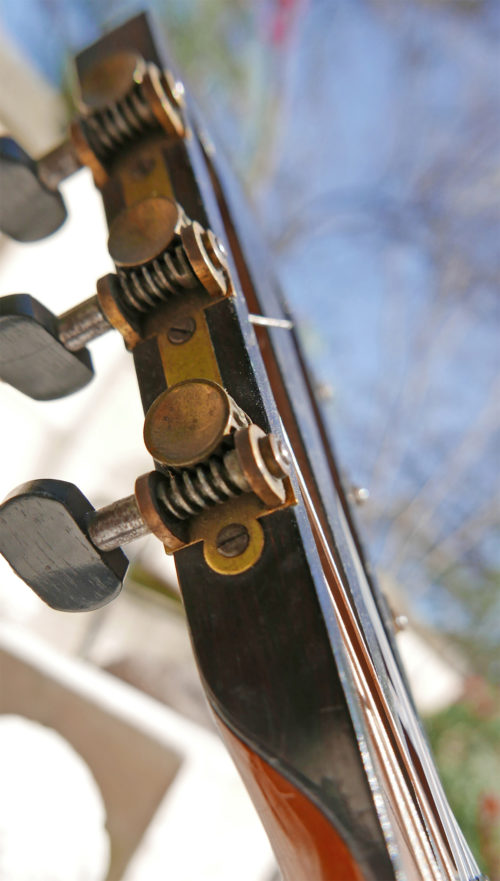 Circa 1860, style 3 guitar built by renowned luthier, James Ashborn of Wolcottville, CT, for William Hall & Son music store. Brazilian rosewood back and sides; Adirondack top; double maple binding (on both back, and front); original coffin case. This guitar is is 100% original, including all original finish, and down to original ebony nut, and original bridge (and saddle) that has never been off the guitar. And it comes in its original wood coffin case, as it left the factory around 1860. This James Ashborn style 3 is rare, and unique because it has brazilian veneer on the neck (not the fretboard which is ebony, but the back of neck), original to the guitar. And, that is very rare for any style/number Ashborn. Also unique to Ashborn’s style 3: his trademark hand-made tuners, have ebony buttons (not rosewood buttons as on his style 1, and 2) And this is a superb sounding Ashborn, unrivaled in tone by any 1850’s/1860’s American guitar we’ve seen and played, including any Martin from that era. Ashborn varied a few details on his guitars (styles 1,2,3, 5), but he did not vary the size of the guitars. He made them all the same body and neck size (unlike Martin for example). They are all the same size. And almost all had spruce/Brazilian veneer on back and sides. As this does. • Nut width is 1 7/8 inches • Width at lower bout: 11 3/8 inches • Scale Length: 24 inches • the action is 4/32 inch on both sides, at 12th string – normal action for this kind of guitar • There are repaired cracks on top, and back of guitar. All professionally repaired. James Ashborn was born in England circa 1816 and came to New England in the late 1830s. Ashborn had his shop in Torrington, but soon after start-up, he began selling guitars to the New York distributor William Hall & Son, whose name appears inside the instruments. From Vintage Guitar magazine: “Ashborn’s design for the guitar was quite innovative for the early 19th century. Instead of making guitars fashioned after the typical parlor-style guitars, he made them in the Spanish style, by taking interior bracing cues from the Spanish while retaining the body of the English guitars. This included a fan brace pattern rather than the more common ladder pattern Ashborn guitars have a very complex dovetail V joint for attaching the head to the neck. The headstock was cut in roughly five steps, using some kind of tracing router, as suggested by the chatter marks on the inside ears of the pegbox. In addition to the complex head design, Ashborn made his own tuning machines in-house. They’re made of brass, very much like contemporary machines, with worm gears, cog gears, and rollers. … Ashborn’s shop was extremely advanced for its time, having a great deal of know-how and technology. Ashborn understood the need to have the technology as well as the skill, but more importantly he discovered a new way of making high-quality instruments that were affordable. He was able to create a factory environment where workers did what they were good at and, with practice, became very fast and consistent. With a new level of consistency in mass production, he created the path followed by other companies such as Martin, Gibson, and Taylor. Using designs ahead of his time, he was able to bring the sound and change to people who otherwise never would have been able to acquire an instrument of this quality.” .... No longer available....
Circa 1860, style 3 guitar built by renowned luthier, James Ashborn of Wolcottville, CT, for William Hall & Son music store. Brazilian rosewood back and sides; Adirondack top; double maple binding (on both back, and front); original coffin case. This guitar is is 100% original, including all original finish, and down to original ebony nut, and original bridge (and saddle) that has never been off the guitar. And it comes in its original wood coffin case, as it left the factory around 1860. This James Ashborn style 3 is rare, and unique because it has brazilian veneer on the neck (not the fretboard which is ebony, but the back of neck), original to the guitar. And, that is very rare for any style/number Ashborn. Also unique to Ashborn’s style 3: his trademark hand-made tuners, have ebony buttons (not rosewood buttons as on his style 1, and 2) And this is a superb sounding Ashborn, unrivaled in tone by any 1850’s/1860’s American guitar we’ve seen and played, including any Martin from that era. Ashborn varied a few details on his guitars (styles 1,2,3, 5), but he did not vary the size of the guitars. He made them all the same body and neck size (unlike Martin for example). They are all the same size. And almost all had spruce/Brazilian veneer on back and sides. As this does. • Nut width is 1 7/8 inches • Width at lower bout: 11 3/8 inches • Scale Length: 24 inches • the action is 4/32 inch on both sides, at 12th string – normal action for this kind of guitar • There are repaired cracks on top, and back of guitar. All professionally repaired. James Ashborn was born in England circa 1816 and came to New England in the late 1830s. Ashborn had his shop in Torrington, but soon after start-up, he began selling guitars to the New York distributor William Hall & Son, whose name appears inside the instruments. From Vintage Guitar magazine: “Ashborn’s design for the guitar was quite innovative for the early 19th century. Instead of making guitars fashioned after the typical parlor-style guitars, he made them in the Spanish style, by taking interior bracing cues from the Spanish while retaining the body of the English guitars. This included a fan brace pattern rather than the more common ladder pattern Ashborn guitars have a very complex dovetail V joint for attaching the head to the neck. The headstock was cut in roughly five steps, using some kind of tracing router, as suggested by the chatter marks on the inside ears of the pegbox. In addition to the complex head design, Ashborn made his own tuning machines in-house. They’re made of brass, very much like contemporary machines, with worm gears, cog gears, and rollers. … Ashborn’s shop was extremely advanced for its time, having a great deal of know-how and technology. Ashborn understood the need to have the technology as well as the skill, but more importantly he discovered a new way of making high-quality instruments that were affordable. He was able to create a factory environment where workers did what they were good at and, with practice, became very fast and consistent. With a new level of consistency in mass production, he created the path followed by other companies such as Martin, Gibson, and Taylor. Using designs ahead of his time, he was able to bring the sound and change to people who otherwise never would have been able to acquire an instrument of this quality.” .... No longer available.... -
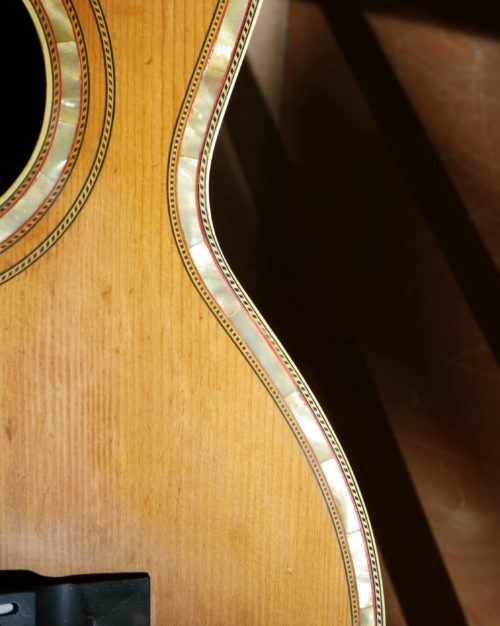 Circa 1912 Mother of Pearl Inlaid Guitar The guitar is extensively inlayed with mother of pearl . The guitar was restored in 2001, work that included converting the instrument to X-bracing, reproduction ebony bridge, reproduction small maple bridge plate. It’s signed inside by the restorer, “B. Lehmann 2001” (Bernie Lehmann, well known luthier in New York.) The guitar has no stamps or labels, but it was probably made by George Bauer – because of many stylistic similarities. The guitar is set up and ready to play. As many guitars of this era, the tone is tilted toward very bright, glassy, brazilian rosewood trebles, not fuller bass. Solid Spruce top Solid Brazilian Rosewood back and sides MOP inlays, fretboard, rosette, and bindings X-braced Original tuners Width at lower bout: 13 1/2 inches Scale Length: 24 7/8 inches Nut Width: 1 ¾ inches V shaped neck .... no longer available....
Circa 1912 Mother of Pearl Inlaid Guitar The guitar is extensively inlayed with mother of pearl . The guitar was restored in 2001, work that included converting the instrument to X-bracing, reproduction ebony bridge, reproduction small maple bridge plate. It’s signed inside by the restorer, “B. Lehmann 2001” (Bernie Lehmann, well known luthier in New York.) The guitar has no stamps or labels, but it was probably made by George Bauer – because of many stylistic similarities. The guitar is set up and ready to play. As many guitars of this era, the tone is tilted toward very bright, glassy, brazilian rosewood trebles, not fuller bass. Solid Spruce top Solid Brazilian Rosewood back and sides MOP inlays, fretboard, rosette, and bindings X-braced Original tuners Width at lower bout: 13 1/2 inches Scale Length: 24 7/8 inches Nut Width: 1 ¾ inches V shaped neck .... no longer available.... -
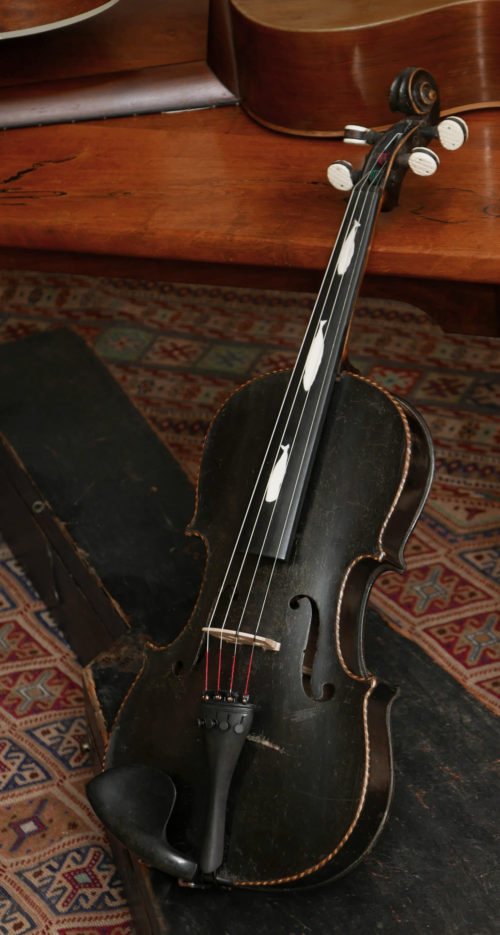 This full-size violin, is a wonderful example of New England whaler culture of the 19th century. The violin itself is probably German made, early 1800’s, with maple back and sides. But the whale inlays (bone) on the fingerboard were no doubt done locally in New England. And the custom, hand made wood case, original to the instrument, also features a brass whale on the top. (Note, the brass handle on the case, is the exact kind used by CF Martin on their coffin cases for guitars in the mid-19th century.) The bridge, and tailpiece are modern. Bone inlays on the tuning pegs also. The instrument is fully set up and ready to play. Price: $2150. In its original wood case, with a brass whale inlay on top.
This full-size violin, is a wonderful example of New England whaler culture of the 19th century. The violin itself is probably German made, early 1800’s, with maple back and sides. But the whale inlays (bone) on the fingerboard were no doubt done locally in New England. And the custom, hand made wood case, original to the instrument, also features a brass whale on the top. (Note, the brass handle on the case, is the exact kind used by CF Martin on their coffin cases for guitars in the mid-19th century.) The bridge, and tailpiece are modern. Bone inlays on the tuning pegs also. The instrument is fully set up and ready to play. Price: $2150. In its original wood case, with a brass whale inlay on top. -
Out of stock
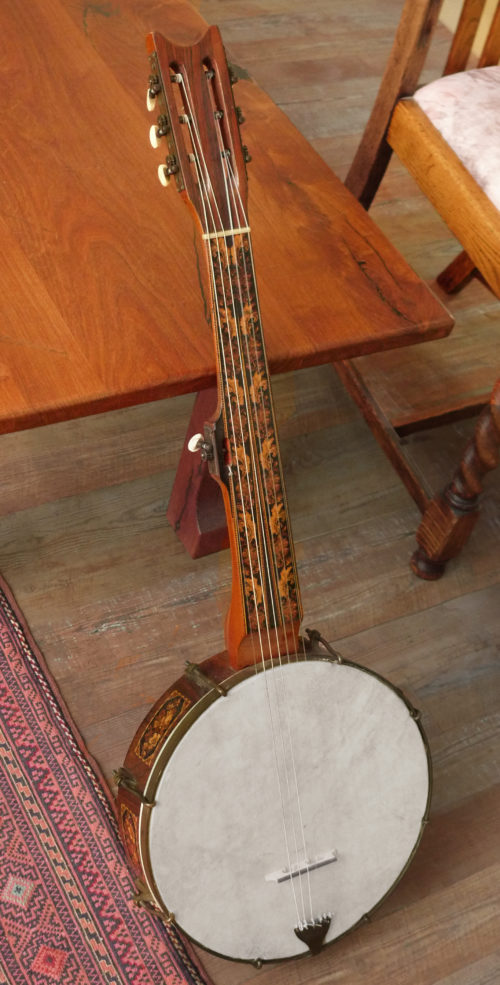 A rare and amazingly original English, Tunbridge ware fretless 7 string banjo. Circa 1850-60. This instrument is 100% original, and even the tailpiece is the original brass tailpiece. This banjo is also rare in that it has original geared tuning machines, not pegs like other examples from the period. The Tunbridge ware banjo is almost impossible to find in this condition and stage of originality. And Tunbridge’s are rare, period. The history? After Joel Sweeney – born to a farming family in Appomattox, Virginia and claimed to have learned to play the banjo from local African population, and the earliest known person to have played the banjo on stage – embarked on a European tour that included stops in London and Edinburgh. He played there for several months, and raised awareness of the instrument in England. As in the U.S., banjos began to be made by local craftsmen – they were still hand made and came in all shapes and sizes, with 5, 6, 7 and even 12 strings, and with one or more drone strings, sometimes on both sides of the neck. Only a few, best ones, such as this instrument, had an amazing amount of work put into them, none more so than those made by a very few firms centered around Tunbridge Wells in Kent, where the local craftsmen specialized in producing a particular form of Treen ware, made from up to 180 different colored woods. Holly, cherry, plum, yew, sycamore, and even imported lignum vitae were all used. The technique was to bind short lengths together and glue them into bundles so when viewed end on, a pattern or picture could be seen. Instrument length: 34 inches. With a 12 inch pot. Eight tensioners and shoes, all original. Original, rare circa 1850 German brass machine tuners (one bent shaft– but still operates perfectly). Original brass tailpiece. Fingerboard, and pot, consisting of inlaid woods as geometric patterns. All the inlays are intact. $2450. In a modern case.
A rare and amazingly original English, Tunbridge ware fretless 7 string banjo. Circa 1850-60. This instrument is 100% original, and even the tailpiece is the original brass tailpiece. This banjo is also rare in that it has original geared tuning machines, not pegs like other examples from the period. The Tunbridge ware banjo is almost impossible to find in this condition and stage of originality. And Tunbridge’s are rare, period. The history? After Joel Sweeney – born to a farming family in Appomattox, Virginia and claimed to have learned to play the banjo from local African population, and the earliest known person to have played the banjo on stage – embarked on a European tour that included stops in London and Edinburgh. He played there for several months, and raised awareness of the instrument in England. As in the U.S., banjos began to be made by local craftsmen – they were still hand made and came in all shapes and sizes, with 5, 6, 7 and even 12 strings, and with one or more drone strings, sometimes on both sides of the neck. Only a few, best ones, such as this instrument, had an amazing amount of work put into them, none more so than those made by a very few firms centered around Tunbridge Wells in Kent, where the local craftsmen specialized in producing a particular form of Treen ware, made from up to 180 different colored woods. Holly, cherry, plum, yew, sycamore, and even imported lignum vitae were all used. The technique was to bind short lengths together and glue them into bundles so when viewed end on, a pattern or picture could be seen. Instrument length: 34 inches. With a 12 inch pot. Eight tensioners and shoes, all original. Original, rare circa 1850 German brass machine tuners (one bent shaft– but still operates perfectly). Original brass tailpiece. Fingerboard, and pot, consisting of inlaid woods as geometric patterns. All the inlays are intact. $2450. In a modern case. -
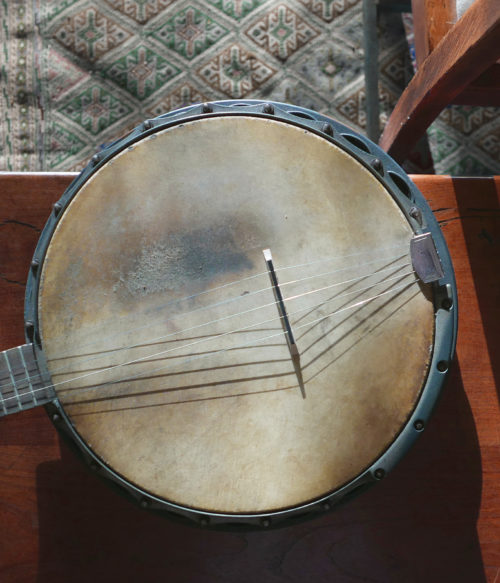 This Banjo has a unique tone, that only comes from a Gretsch Die-cast metal shell/flange construction, prewar banjo. But it’s rare to see these banjos in anything other than tenor. This one is a rare, original 5 string configuration, and has a nice “Gretsch growl” (a term that some drummers use to describe Gretsch drums). Wonderful, dark tone, with bell-like high notes. And with a bit of sustain that is reminiscent of a prewar Dobro guitar. Growl, plus sustain, and ringing highs – only from a Gretsch prewar banjo. Pearloid heastock overlay. 11 inch head. 26 inch scale length. 22-fret Brazilian rosewood fingerboard, with dot markers. Walnut neck, and resonator. Top tension head adjustment with 20 lugs. Original calf skin head. Price: $750.
This Banjo has a unique tone, that only comes from a Gretsch Die-cast metal shell/flange construction, prewar banjo. But it’s rare to see these banjos in anything other than tenor. This one is a rare, original 5 string configuration, and has a nice “Gretsch growl” (a term that some drummers use to describe Gretsch drums). Wonderful, dark tone, with bell-like high notes. And with a bit of sustain that is reminiscent of a prewar Dobro guitar. Growl, plus sustain, and ringing highs – only from a Gretsch prewar banjo. Pearloid heastock overlay. 11 inch head. 26 inch scale length. 22-fret Brazilian rosewood fingerboard, with dot markers. Walnut neck, and resonator. Top tension head adjustment with 20 lugs. Original calf skin head. Price: $750. -
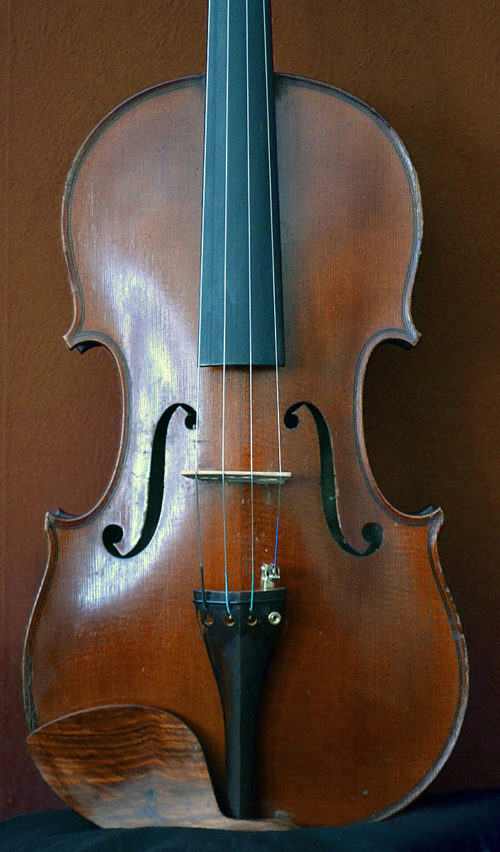 Full size, Charles Fetique violin (French, early 20th century – circa 1930), with original label inside. This is a rich, sonorous instrument. A deep, round tone, that – like all good violins – does not make you work overly hard to attain. It has a darker, lush, round tone that professional players love – and great projection. We recently A-B'd this instrument against $5k+ violins in the area, and there was no comparison, this instrument was louder, more full, more round and full in the bass notes, and all around a stellar performer. This violin would be a great student violin upgrade – for that aspiring violinist who is ready to graduate to, and enjoy, a better instrument than what's typically available in the $4-5K range, at a very attractive price. And, the buyer will have the confidence of both a Letter of Expertise, and a professional appraisal: • Certificate: Jean-Jacques Rampal, Paris, 2014. (This is the letter of expertise, on this violin, from one of the top experts on French Violins, in Paris, France). And: • Written, professional appraisal of the violin, done from personal inspection, from one of the top violin shops/experts in Texas (Jay R. Rury Violins, Dallas), with a valuation of $3,500.00 Both the above documents will be included with the sale. The violin is in excellent condition. There are no sound post, or bass bar cracks. It was professionally set up to play, by Blackerby Violin in Austin. In a modern Tonerelli case. Price: $3250.
Full size, Charles Fetique violin (French, early 20th century – circa 1930), with original label inside. This is a rich, sonorous instrument. A deep, round tone, that – like all good violins – does not make you work overly hard to attain. It has a darker, lush, round tone that professional players love – and great projection. We recently A-B'd this instrument against $5k+ violins in the area, and there was no comparison, this instrument was louder, more full, more round and full in the bass notes, and all around a stellar performer. This violin would be a great student violin upgrade – for that aspiring violinist who is ready to graduate to, and enjoy, a better instrument than what's typically available in the $4-5K range, at a very attractive price. And, the buyer will have the confidence of both a Letter of Expertise, and a professional appraisal: • Certificate: Jean-Jacques Rampal, Paris, 2014. (This is the letter of expertise, on this violin, from one of the top experts on French Violins, in Paris, France). And: • Written, professional appraisal of the violin, done from personal inspection, from one of the top violin shops/experts in Texas (Jay R. Rury Violins, Dallas), with a valuation of $3,500.00 Both the above documents will be included with the sale. The violin is in excellent condition. There are no sound post, or bass bar cracks. It was professionally set up to play, by Blackerby Violin in Austin. In a modern Tonerelli case. Price: $3250. -
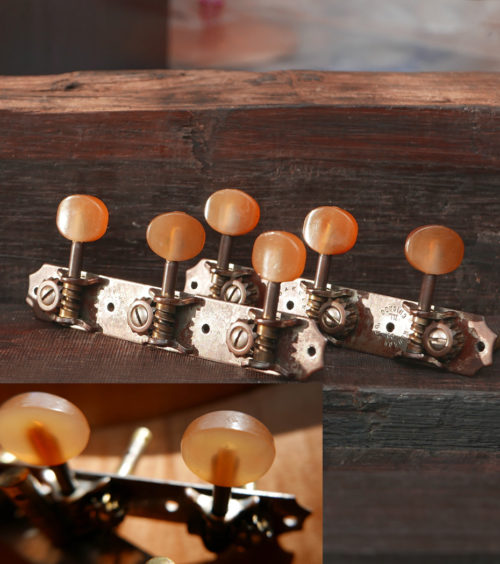 Pre-war Kluson tuners from the 1930's. Amber buttons. These are rare tuners that came on some of the nice Gibsons of the era, such as a few Gibson J35's. Good working condition. Price: $295. – on Hold
Pre-war Kluson tuners from the 1930's. Amber buttons. These are rare tuners that came on some of the nice Gibsons of the era, such as a few Gibson J35's. Good working condition. Price: $295. – on Hold -
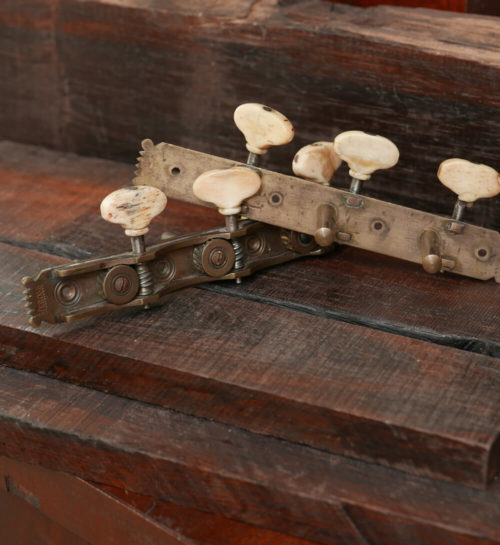 Even more rare, early Jerome’s, made in France. Circa 1840 -1850. Unusual design. Missing one post/worm gear. Damage to one worm gear bracket. Price: $795.
Even more rare, early Jerome’s, made in France. Circa 1840 -1850. Unusual design. Missing one post/worm gear. Damage to one worm gear bracket. Price: $795. -
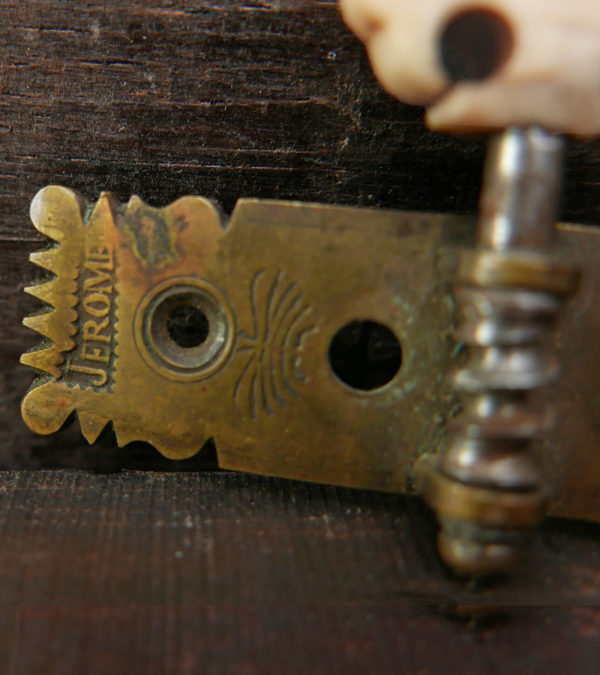 Very rare, early Jerome guitar tuners, made in France. Rare kidney buttons, as seen on higher end Martin guitars from the 1840s, 1850s, and 1860's. Plates, shafts and buttons only. No posts or worm gears (there is one post and one worm gear). Price: $595.
Very rare, early Jerome guitar tuners, made in France. Rare kidney buttons, as seen on higher end Martin guitars from the 1840s, 1850s, and 1860's. Plates, shafts and buttons only. No posts or worm gears (there is one post and one worm gear). Price: $595. -
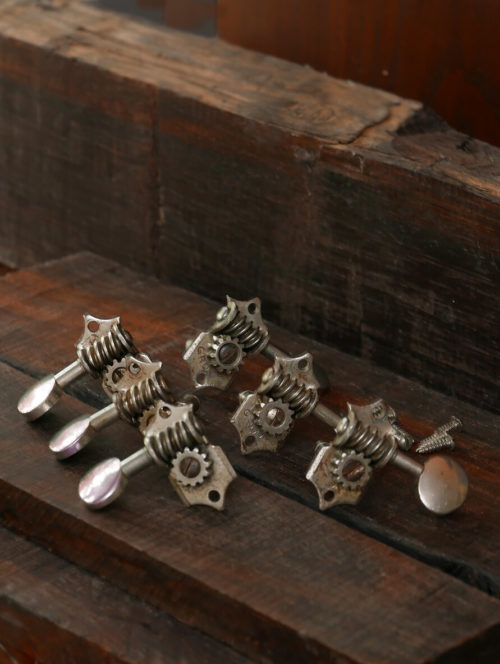 6:1 ratio pre war Grovers, mid-1930's. As used on Martin pre-war dreadoaught guitars. Oval buttons, bevelled edges on the baseplate. Just one button has some missing chrome on one side (see photos). With bushings, and mounting screws. No bent shafts. Good working condition. Price: $795.
6:1 ratio pre war Grovers, mid-1930's. As used on Martin pre-war dreadoaught guitars. Oval buttons, bevelled edges on the baseplate. Just one button has some missing chrome on one side (see photos). With bushings, and mounting screws. No bent shafts. Good working condition. Price: $795. -
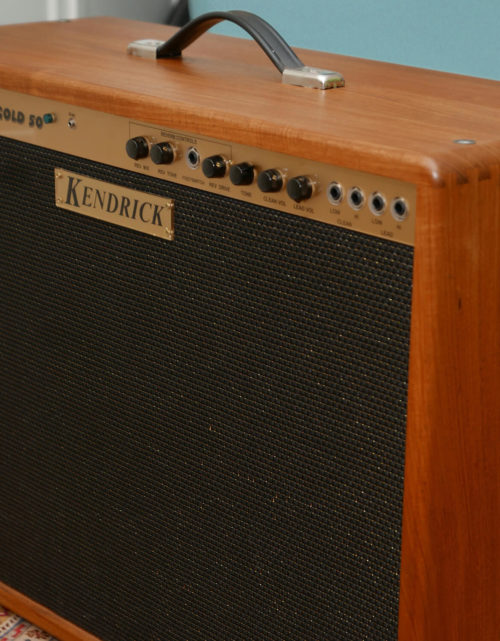 This was one of the best amps ever made by the legendary Gerald Weber. All-tube circuitry, designed and made in the USA, by Weber. It not only has power to spare (50 watts), but its unique circuitry has two channels, clean and lead, with different preamp circuit. These channels can be blended through patching the second input of one channel into the first input of the other, for purposes of blending the two channels together and further tone shaping with the interactive tone circuit. The bottom line: Tons of power if you need it, but the ability to get all the creamy, lush lead tones with the lead channel and/or blending. You just have to hear it. Original, handmade hardwood cabinet. 2 x 12: one 12 inch Kendrick brown frame and one 12 inch Kendrick black frame speaker. Kendrick's double spring reverb with three controls. Great condition. Recently serviced by one of the best amp techs in Texas. Price: $1495. No shipping. Local pickup only in Austin.
This was one of the best amps ever made by the legendary Gerald Weber. All-tube circuitry, designed and made in the USA, by Weber. It not only has power to spare (50 watts), but its unique circuitry has two channels, clean and lead, with different preamp circuit. These channels can be blended through patching the second input of one channel into the first input of the other, for purposes of blending the two channels together and further tone shaping with the interactive tone circuit. The bottom line: Tons of power if you need it, but the ability to get all the creamy, lush lead tones with the lead channel and/or blending. You just have to hear it. Original, handmade hardwood cabinet. 2 x 12: one 12 inch Kendrick brown frame and one 12 inch Kendrick black frame speaker. Kendrick's double spring reverb with three controls. Great condition. Recently serviced by one of the best amp techs in Texas. Price: $1495. No shipping. Local pickup only in Austin.